Recovery is hard — not just on the body, but on the mind. Physical therapy can feel slow, repetitive, and frustrating, especially when results take time to show. Many people begin with hope, only to feel discouraged when progress doesn’t come quickly. That emotional weight often becomes the biggest obstacle to healing.
But what if recovery could feel different? What if physical therapy didn’t drain motivation — but actually boosted it? What if patients looked forward to their rehab sessions, not because they had to, but because they wanted to?
That’s where gamification comes in.
Gamification isn’t just about adding points or scores to exercises. It’s about using the brain’s natural love for challenges, rewards, and growth to change the way people feel about recovery. And when it’s done right, it transforms physical therapy from a task into a journey — one that feels purposeful, rewarding, and even fun.
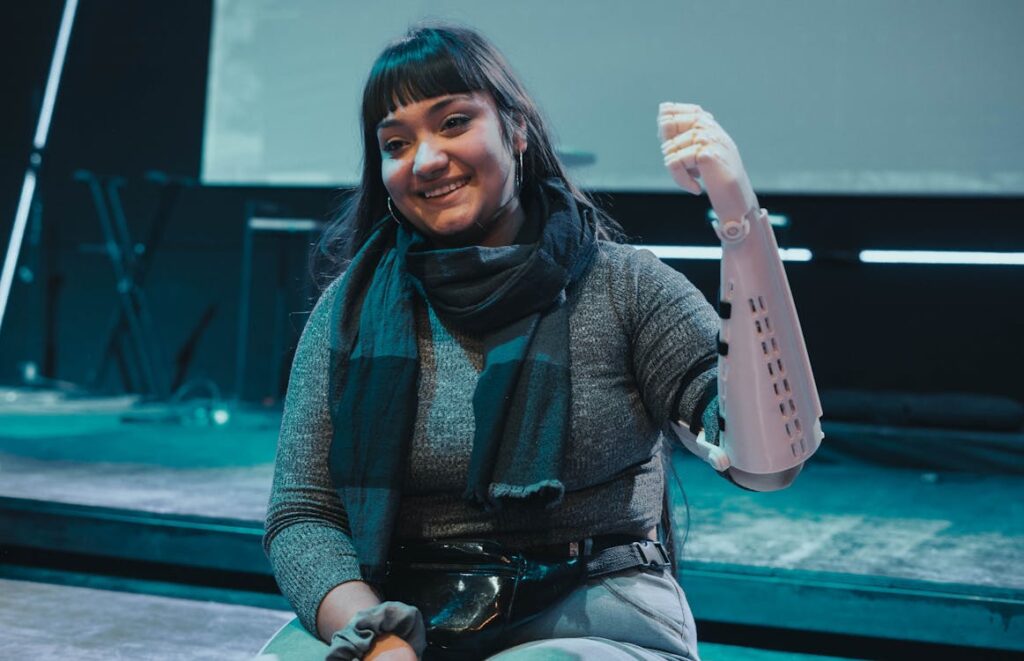
Why Motivation Matters More Than We Think in Physical Therapy
The Emotional Weight of Recovery
When someone starts physical therapy, especially after a life-changing event like amputation or injury, the journey ahead can feel like climbing a mountain. The exercises are unfamiliar. The progress is slow. The goals can seem far away. And for many, the hardest part is simply staying motivated through the process.
Motivation is what keeps a person showing up, trying again, and pushing past setbacks. But physical therapy, by its very nature, tests that motivation. Sessions often involve repeating the same movements over and over. The setting can feel clinical. There are no quick wins. Some days feel like a step forward, others like two steps back. It’s not surprising that so many patients lose interest, skip sessions, or give up halfway.
This isn’t about laziness or lack of discipline. It’s human psychology. Our brains are wired to seek reward, novelty, and feedback. When those things are missing, motivation drops. And when motivation drops, so does consistency — which directly slows down recovery. That’s why therapists often say that mindset is just as important as muscle in physical rehabilitation.
Gamification as a Motivational Engine
Gamification works because it taps into that natural desire for reward and progress. At its core, it uses simple psychological triggers — success, recognition, curiosity, and challenge — to create an emotional pull toward action.
Take something as simple as a score. When a patient performs a movement and sees their score improve, the brain registers it as a win. That win releases dopamine — a chemical linked to pleasure and motivation. Suddenly, the action doesn’t just feel like hard work. It feels like an achievement. And when the brain senses achievement, it wants more.
Or think about levels and progression. In traditional therapy, improvement is measured by small changes over long periods. That’s important but not very exciting. Gamification breaks those long goals into smaller milestones. You don’t just try to improve range of motion — you try to “complete the next level” in a game that mirrors that motion. Each level feels like progress. Each step feels like purpose. And the patient stays engaged.
What’s even more powerful is that gamification gives patients control. Instead of waiting for someone to tell them how they’re doing, they get instant feedback. They know if they’re improving. They can see their efforts pay off in real time. That sense of control boosts confidence — and confidence is fuel for effort.
The Brain’s Need for Play, Even in Serious Situations
Many people think play is only for children. But play is actually a deep, instinctive human need. It’s how we learn, how we adapt, and how we stay curious. Even in adulthood, play offers a break from routine. It refreshes the mind. It brings back a sense of agency — the feeling that we can shape outcomes, not just endure them.
In physical therapy, especially after trauma, this is critical. A patient may feel like life is happening to them. Like they’ve lost control of their body, their time, their freedom. Gamification reintroduces a sense of playful control. Even when the body is in pain, the brain can still feel joy through small victories. That emotional shift can change everything.
It doesn’t mean therapy becomes a game. It means therapy becomes gameful — structured in a way that makes the patient feel engaged, challenged, and rewarded. And that shift in feeling often leads to better performance, more consistency, and longer-term commitment to the recovery process.
Why Repetition Without Emotion Doesn’t Work
Physical therapy often requires repeating movements thousands of times to build strength, coordination, or muscle memory. But repetition alone isn’t enough. For the brain to truly adapt, it needs attention and emotion. That’s why bored or distracted practice doesn’t produce the same results as engaged practice.
Gamification adds emotional weight to repetition. Each movement has meaning — not just because it’s good for the body, but because it achieves something visible. Maybe it moves a character forward in a game. Maybe it triggers a sound, a color change, or a reward. These cues give the brain something to latch onto. They make the movement feel important, even exciting.
This matters especially when a patient is tired, discouraged, or in pain. On hard days, emotional connection to the task can be the difference between giving up and pushing through. Gamification turns repetition from a grind into a challenge. And challenges, when designed right, invite persistence.
Internal vs. External Motivation — And How Games Bridge the Gap
There are two main kinds of motivation: internal and external. Internal motivation comes from within — the drive to heal, to improve, to regain independence. External motivation comes from outside — rewards, praise, scores, competition. Both are important in rehab, but they work in different ways.
Gamified therapy starts by using external motivators. It gives the patient scores, feedback, and visible rewards to kickstart engagement. But over time, something deeper happens. The patient begins to feel proud of their progress. They start to enjoy the movement itself. The need for points or badges fades, and they continue because they want to improve.
That’s the real power of gamification — it helps patients move from “I have to do this” to “I want to do this.” It starts with the outside, but slowly builds from the inside. And when motivation becomes internal, it lasts far beyond the game.
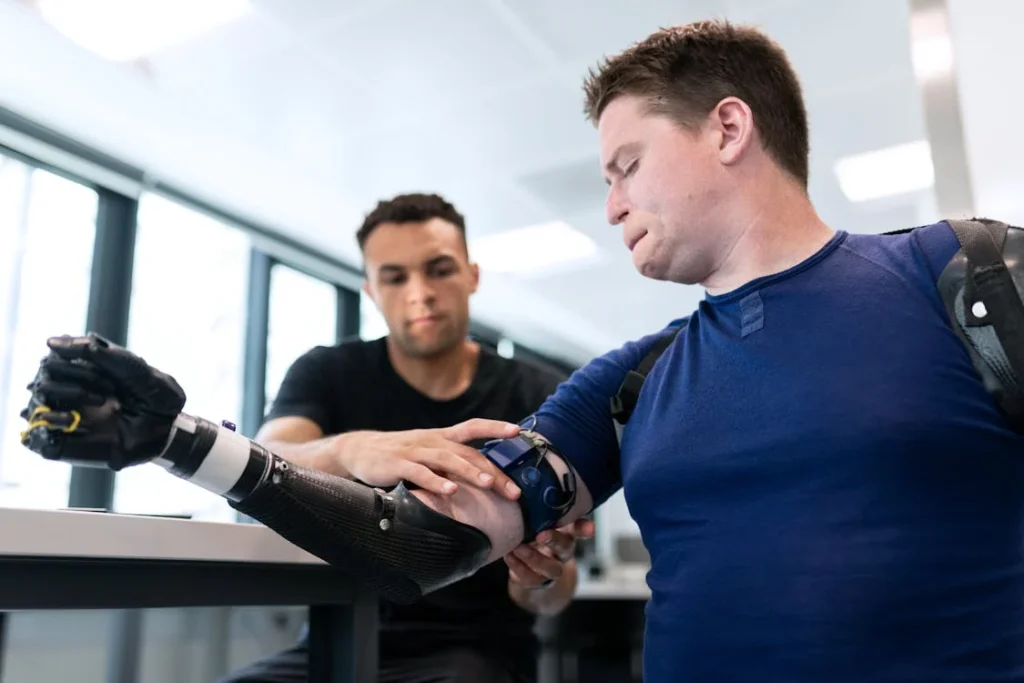
The Psychology of Reward, Progress, and Emotional Connection
How the Brain Responds to Success Signals
Every time we achieve something — no matter how small — our brain gives us a little chemical reward. This reward usually comes in the form of dopamine, a neurotransmitter that makes us feel good, focused, and eager to do the action again. It’s why we feel a tiny rush when we solve a puzzle, complete a task, or even get a “like” on social media.
In physical therapy, however, success can be slow. Progress might take weeks to notice. And in the meantime, the patient may feel like they’re working hard with nothing to show for it. That’s where gamification comes in.
It creates frequent, clear signals of success. When a patient lifts their arm to the right position, the game flashes a visual cue or sound effect. If they complete a set of movements, a virtual badge appears. These may seem like small gestures — but to the brain, they are powerful.
This constant stream of feedback helps the brain stay engaged. It tells the patient, “Yes, this matters. Keep going.” And that kind of encouragement doesn’t just come from the therapist anymore — it’s built into the system, responding instantly and consistently every time.
Progress Feeds Persistence
One of the hardest parts of long-term therapy is staying committed when things feel repetitive. A patient may not always notice how much they’ve improved. They may lose track of where they started or how far they’ve come. But gamification changes that by offering visual proof of progress.
Many rehab games show growth through levels, points, progress bars, or unlocked achievements. When a patient sees themselves move from Level 2 to Level 5, they don’t need anyone to explain that they’ve improved — they can see it for themselves. That sense of movement is deeply satisfying. It gives them a reason to show up the next day.
This structure mimics how we grow in life. We move forward step by step. We collect small wins. We measure our success over time. Gamified rehab honors that rhythm. It doesn’t rush the process, but it makes sure the patient always feels like something is happening. And that feeling — of always improving, even a little — is often what keeps someone going when they might otherwise stop.
Emotional Safety Through Engagement
One of the most overlooked parts of therapy is the emotional experience of the patient. After an injury or amputation, people often carry emotional weight — grief, shame, frustration, fear. Traditional therapy settings can feel vulnerable. Patients may worry about failing, about not doing well, or about being watched.
Gamified rehab softens that emotional load. It creates a safe space to try, to fail, and to try again. In a game, failure doesn’t feel like a judgment — it feels like feedback. Missed a movement? Try again. Didn’t score high? Improve next round. This shift from failure to feedback changes how people approach difficulty. It invites persistence, not embarrassment.
For children, this is especially powerful. A child recovering from limb loss may be shy, scared, or self-conscious. But put them in a playful environment where their avatar collects stars or defeats a cartoon dragon — and suddenly, their eyes light up. They move with confidence, curiosity, and joy. They forget they’re in rehab. And in that forgetting, they heal.
The Importance of Autonomy and Choice
Psychologists have long known that people perform better when they feel a sense of autonomy — the ability to make choices, control outcomes, and shape their own experience. In traditional therapy, much of the structure is fixed. The therapist decides the exercises, the pace, and the progress markers. The patient follows.
Gamification introduces choice. Even in a simple setup, a patient might choose which game to play, which level to attempt, or how long to train. These small decisions add up. They make the patient feel in control of their own healing. They become more than just a participant — they become an active agent in their recovery.
This is especially important for adults, who may already feel a loss of independence due to their condition. Choosing their path, their pace, and their rewards helps restore a sense of dignity. It turns recovery from a passive process into a personal mission.
Narratives That Create Meaning
Another fascinating psychological element used in gamified therapy is narrative — the use of story to give tasks emotional weight. Instead of just performing a set of movements, a patient might be “rescuing a lost character,” “building a digital city,” or “completing a space mission.” These aren’t just fun ideas — they’re designed to trigger meaningful engagement.
When actions have context, people care more. When tasks are framed as part of a journey, people invest more. They don’t just stretch or lift — they advance a story. And in advancing that story, they feel a deeper connection to the task.
This storytelling model makes therapy more human. It connects the body and mind in a shared experience. And when that happens, patients don’t just go through the motions — they immerse themselves. They feel part of something bigger. And that emotional immersion often leads to stronger, faster, and longer-lasting outcomes.
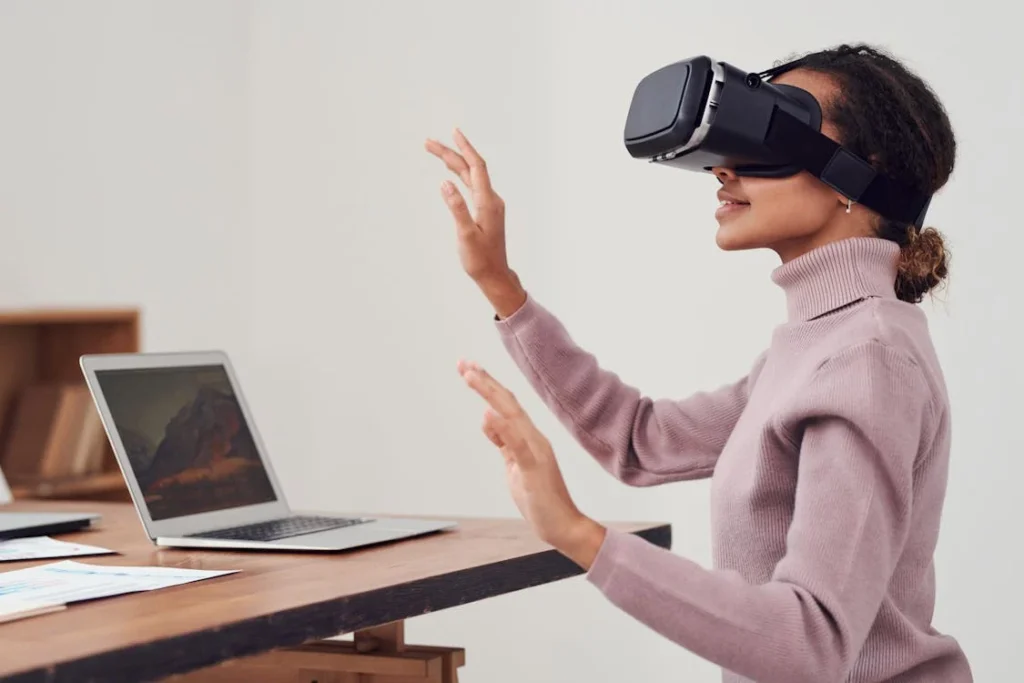
Gamification and Behavior Change in Long-Term Rehabilitation
Turning Short-Term Engagement into Long-Term Habits
One of the biggest challenges in physical therapy is consistency. Many patients start strong — especially in the first few weeks — but motivation fades over time. Life gets busy. The body gets tired. Progress begins to feel invisible. And slowly, the patient stops showing up, both physically and mentally. That’s when recovery begins to stall.
The key to overcoming this isn’t just better instruction — it’s better behavior design. In other words, we need to make good habits stick. And this is where gamification shines.
By building therapy into a structure of rewards, routines, and progress, gamification creates the conditions for habit formation. The patient isn’t just told what to do. They’re encouraged to repeat tasks through positive reinforcement. Each session becomes a loop: perform the action, get immediate feedback, feel good about the progress, and repeat.
When this loop is repeated regularly — even in short bursts — it begins to shape long-term behavior. What starts as a daily game soon becomes a daily habit. And unlike willpower, which is fragile, habits are automatic. They carry patients through rough days, low moods, and physical fatigue — not because of motivation, but because of routine.
Why Small Wins Matter More Than Big Goals
Many people begin rehab with large goals: to walk again, to regain full mobility, to return to work. These goals are important. But they can also feel distant and overwhelming, especially in the early stages. When improvement comes in small, invisible steps, patients may feel like they’re not moving at all.
Gamification flips this dynamic by focusing on micro-achievements. Instead of waiting for a massive breakthrough, it celebrates tiny wins — a smoother movement, a quicker response, a higher score, a completed level. These small victories fuel morale. They show the patient that every bit of effort counts.
This approach works because the human brain is wired to chase progress. We don’t need huge leaps to feel motivated — we need to feel that we’re better today than we were yesterday. Gamification delivers that feeling by making progress visible, trackable, and emotionally rewarding. And when that feedback loop is reinforced day after day, it builds belief: “I am getting better.”
Reducing Friction to Improve Follow-Through
Another reason patients fall off their therapy plans is friction — the little things that make rehab feel inconvenient. Maybe it’s a long trip to the clinic. Maybe the exercises feel dull. Maybe the instructions are confusing. Over time, these points of friction pile up and push the patient away.
Gamified rehab lowers this friction. It turns therapy into something that can often be done at home, with minimal equipment. The experience feels smooth, intuitive, and even enjoyable. Instructions are built into the game itself. Visual cues guide the patient. There’s no need for long explanations or written homework. The game teaches by doing.
And because the environment is designed to be fun and user-friendly, the patient doesn’t need extra motivation to start — they just need to press play. This simplicity removes barriers to action. It turns rehab from a chore into something easy to begin. And when it’s easy to begin, it’s more likely to happen again and again.
Creating Accountability Without Pressure
Accountability is crucial in physical therapy. Patients who feel responsible for their progress tend to perform better. But traditional accountability — regular check-ins, strict routines — can sometimes feel like pressure. And pressure can backfire, especially when a patient is already dealing with stress or pain.
Gamified rehab offers a gentler form of accountability. The game itself tracks progress. It reminds the user when they’ve missed sessions. It gives them visual proof of how far they’ve come — and what’s left to do. This kind of feedback doesn’t scold. It nudges. It encourages.
Some platforms also include community elements, like leaderboards or multiplayer challenges. These features invite patients to stay active, not because they’re being watched, but because they want to be part of something. They want to keep up with peers, unlock the next challenge, or contribute to a team goal.
This softer accountability feels less like a deadline and more like a personal mission. It’s internal, not imposed. And that shift from external pressure to internal drive makes a huge difference in long-term commitment.
Helping the Brain Rewrite the Story of Recovery
Behind every physical injury is a mental story. Some patients see themselves as survivors. Others feel like victims. Some are hopeful. Others are overwhelmed. These stories shape how they approach therapy — whether they push forward, pull back, or give up.
Gamified rehab gives patients a new story to tell themselves — one of growth, strength, and possibility. It reframes rehab from “fixing what’s broken” to “building what’s next.” It invites the patient to see themselves not as someone healing from a setback, but as someone leveling up.
That’s a powerful psychological shift. It replaces shame with pride. It replaces fear with curiosity. It replaces frustration with challenge.
And when that story changes, everything else changes too — effort, consistency, resilience, and ultimately, results.
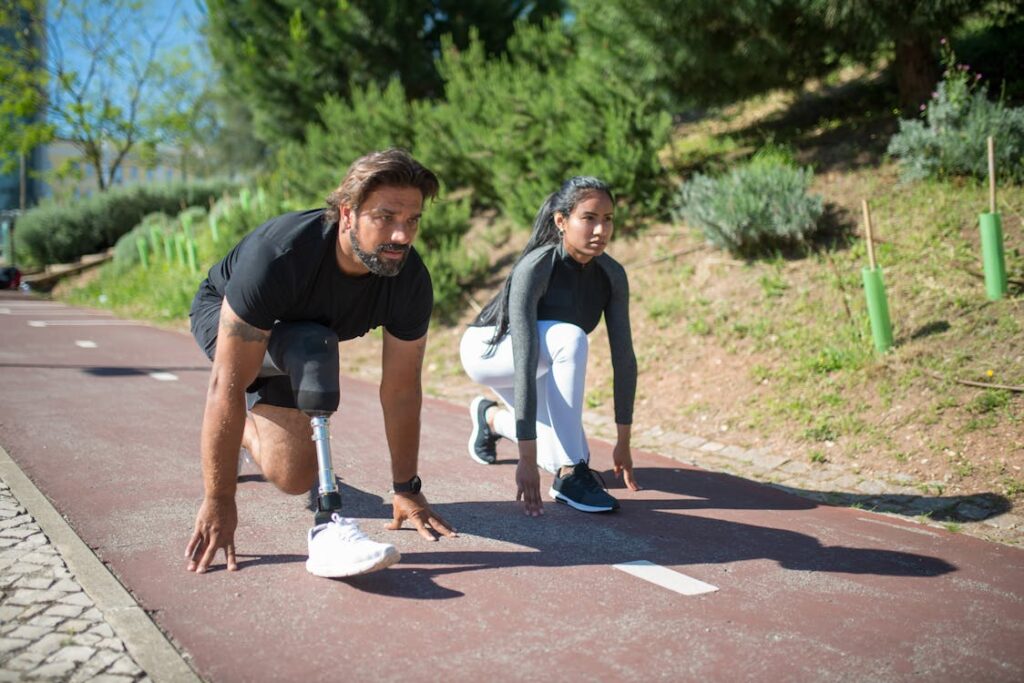
Gamification and Emotional Resilience During Physical Rehabilitation
Rehab Isn’t Just Physical — It’s Mental and Emotional
Anyone who has ever gone through physical therapy knows it’s not just about muscles, joints, or coordination. It’s about facing yourself in moments of struggle, doubt, and discomfort. Recovery can feel like a rollercoaster — one day you feel strong and capable, the next you wonder if you’ll ever get back to “normal.” It’s easy to feel stuck, defeated, or emotionally drained, especially when progress is slow.
This emotional weight can take a toll on motivation. Even small setbacks — a missed session, a failed movement, an increase in pain — can feel like proof that things aren’t working. Over time, these moments stack up, and patients begin to pull away from therapy, even if their bodies are improving.
What’s needed in these moments isn’t just another exercise. It’s a new emotional framework — one that invites patience, joy, and resilience. And this is one of the most underappreciated strengths of gamified rehab.
Games Teach Us How to Lose — and Try Again
In every well-designed game, failure is not the end. It’s expected. It’s part of the experience. You make a mistake, learn from it, and try again. There’s no shame — only progress. This idea, while simple, is deeply powerful in a rehab setting.
Gamified physical therapy systems are built to reinforce this mindset. Missed a target? No problem. The game lets you try again. Didn’t reach the next level? Keep playing. The entire structure is based on persistence, not perfection. And every small improvement — even after failure — is noticed and rewarded.
For patients, this changes the emotional tone of recovery. Instead of being frustrated by setbacks, they begin to see them as part of the process. They understand that healing isn’t linear — that ups and downs are natural. This shift builds resilience, not just physically, but mentally. And resilience is one of the most valuable traits a patient can develop during long-term recovery.
Gamification as a Tool to Fight Anxiety and Self-Doubt
One of the hardest feelings to manage during rehab is self-doubt. Patients often compare themselves to how they used to be. They wonder if they’ll ever be as fast, as strong, or as independent again. These thoughts can lead to anxiety — not just about the present, but about the future.
Games act as emotional anchors. They bring focus into the moment. Instead of worrying about long-term outcomes, patients focus on short-term actions: completing the next level, improving their score, or mastering a specific movement. This present-moment focus reduces anxiety. It gives the mind a clear, manageable task — something concrete to do, right now.
And because the feedback is instant and positive, patients receive emotional reinforcement. They don’t have to wait for a big milestone to feel good. Every game session brings a small burst of pride, confidence, and validation. Over time, these moments add up. They change how patients see themselves. Not as people who are “broken,” but as people who are improving, capable, and in control.
The Joy Factor in Difficult Times
There’s something else gamification offers that traditional therapy rarely does: joy. The kind of joy that comes from accomplishment, from play, from surprise. In the middle of a difficult recovery, these moments matter more than we realise.
Laughter, excitement, and curiosity are powerful healers. They remind the patient that life still holds good things — even in the middle of a long journey. When therapy is fun, the brain associates the experience with pleasure, not pain. This makes the patient more likely to return to it, even on hard days.
Some rehab games add music, color, sound effects, or friendly characters to create a positive emotional atmosphere. These touches may seem playful, but their impact is serious. They change the emotional landscape of the session. Instead of dread or boredom, patients feel energy. They smile. They try harder — not because they were told to, but because they want to.
Joy creates momentum. And in therapy, momentum is gold.
Gamification Helps Rebuild Identity and Purpose
Perhaps the most profound impact of gamified rehab is its role in helping patients redefine who they are. After an injury or amputation, many people experience a shift in identity. They may no longer feel like themselves. They may question their worth, their strength, or their role in the world.
Traditional rehab focuses on restoring function. Gamified rehab goes a step further — it helps restore identity. It gives patients challenges they can win, stories they can participate in, and achievements they can claim. They stop seeing themselves as just patients. They become players, adventurers, learners, achievers.
This new identity has ripple effects. It boosts self-esteem. It fuels social connection. It opens the door to new goals — returning to work, participating in sports, reconnecting with hobbies. And it reminds the patient that recovery isn’t just about returning to who they were. It’s about discovering who they can be next.
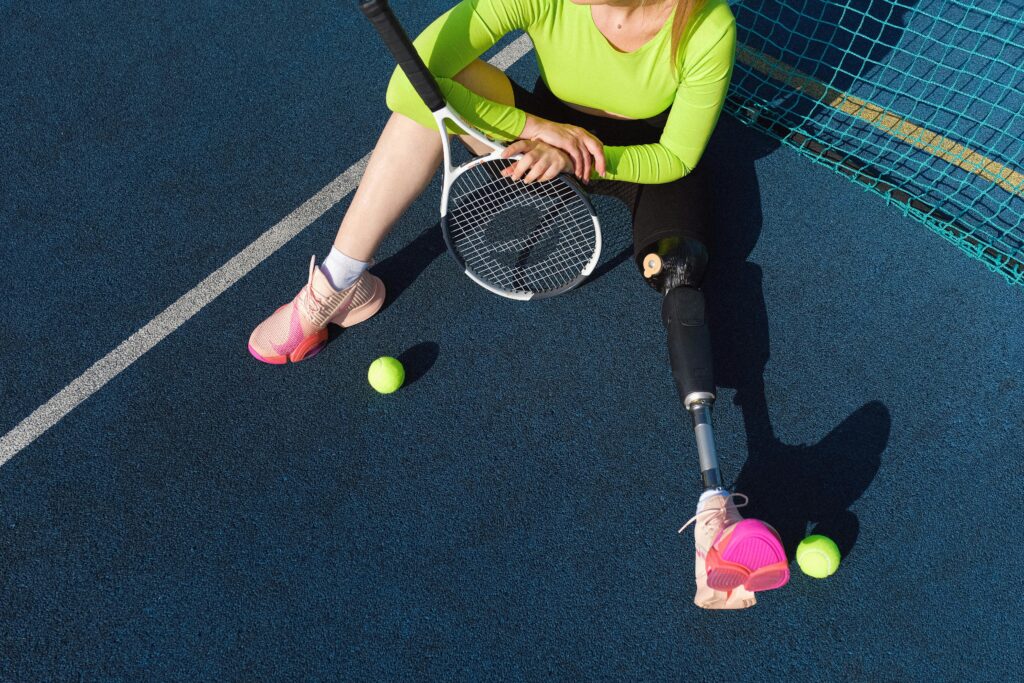
The Neuroscience Behind Gamification in Therapy
Understanding the Brain’s Learning Loop
At the core of any rehabilitation process is neuroplasticity — the brain’s natural ability to change and form new pathways in response to experience. When someone loses a limb or suffers an injury, the brain has to relearn how to move, adapt, and respond. Every motion in therapy isn’t just a physical act — it’s a message sent to the brain saying, “Learn this. Remember this. Make it easier next time.”
But for the brain to truly learn, it needs three key ingredients: repetition, attention, and emotional engagement. This is where traditional rehab often falls short. While repetition is built in, attention tends to fade due to monotony, and emotional engagement can be minimal — especially when patients feel discouraged or disconnected.
Gamification ties these three ingredients together in a way that feels effortless. Every game session provides structured repetition. The interactive nature of gameplay holds attention. And the rewards, visuals, and feedback keep the user emotionally engaged. This trifecta creates the perfect storm for neuroplasticity to do its work — rewiring the brain for better movement, faster adaptation, and deeper recall.
The Dopamine Connection
Every time we experience something rewarding — whether it’s winning a level in a game, scoring a point, or hearing a positive sound — our brain releases dopamine. This chemical doesn’t just make us feel good. It actually enhances learning.
Dopamine helps the brain flag experiences as important. It tells our neural circuits, “Pay attention — this matters.” When patients receive constant, positive feedback during gamified therapy, their brains associate the action with pleasure. That pleasure creates a memory loop. The body remembers the movement not just mechanically, but emotionally. This helps cement the skill faster and makes patients more likely to repeat the action again.
In essence, dopamine isn’t just keeping people happy during therapy. It’s helping their brains learn faster and better. This is especially valuable for individuals learning to use complex devices like bionic limbs or new prosthetic systems — where brain-muscle coordination is key.
Mirror Neurons and Motivation
Another fascinating brain mechanism involved in gamified rehab is the role of mirror neurons. These are cells in the brain that activate not just when we perform an action, but when we observe someone else doing the same thing. They play a key role in empathy, imitation, and learning by example.
Many gamified systems include avatars or virtual models performing the correct movement. When patients see these models, their mirror neurons fire, helping them internalize the motion even before they try it themselves. This primes their brain and body for better execution.
It also adds to motivation. When patients see their own avatar move smoothly in a digital space, it creates a psychological sense of possibility. “If my character can do this, maybe I can too.” That subtle boost in confidence often leads to better performance in the physical task.
Multisensory Stimulation for Deeper Engagement
Gamified rehab doesn’t rely on just one sense. It often combines visual cues, auditory feedback, and even tactile responses. This multisensory approach helps activate more areas of the brain, leading to deeper processing and better recall.
When the eyes are engaged by motion, the ears are stimulated by rewarding sounds, and the body is actively moving — the brain becomes fully involved. This whole-brain activation strengthens learning pathways. It’s the difference between reading a manual and playing a game that shows you what to do, tells you when it’s right, and rewards you for getting better.
This approach is especially helpful for patients with cognitive challenges, learning difficulties, or trauma-related fatigue. It reduces cognitive overload by keeping engagement natural and intuitive, rather than mentally forced.
Gamification and Brain-Body Coordination
For many patients using prosthetics, especially myoelectric or bionic devices, learning to control the limb isn’t just about strength — it’s about precision. They must train their brains to send very specific signals to the right muscles, with the right timing, in the right amount.
Gamified rehab tools are uniquely suited for this kind of training. They can detect micro-movements, adjust difficulty on the fly, and provide live feedback when a movement is too slow, too weak, or too shaky. Over time, this process sharpens the patient’s brain-body connection — like tuning a musical instrument to perfect pitch.
This fine-tuning of control is critical. It means fewer errors in real-world tasks. It reduces fatigue. It builds confidence. And it increases the chances of long-term prosthetic use, because the limb feels more like a natural extension of the self, not a foreign object.
Emotional Memory and Long-Term Adoption
One of the lesser-known facts about memory is that we remember how something made us feel more than the exact details. This is called emotional memory. If a patient’s early experience with a prosthetic is filled with frustration and confusion, they may unconsciously associate the device with negative feelings — even if they later gain function.
Gamification helps overwrite those early emotional patterns with positive ones. It creates a learning environment filled with encouragement, joy, and small victories. These emotions anchor the memory of success — and that emotional anchor increases the chance of long-term commitment to the therapy and the device.
Instead of seeing rehab as a reminder of what they lost, patients begin to see it as a path to something better. This emotional reframing — powered by gamified experience — is one of the most powerful tools we have for lasting change.
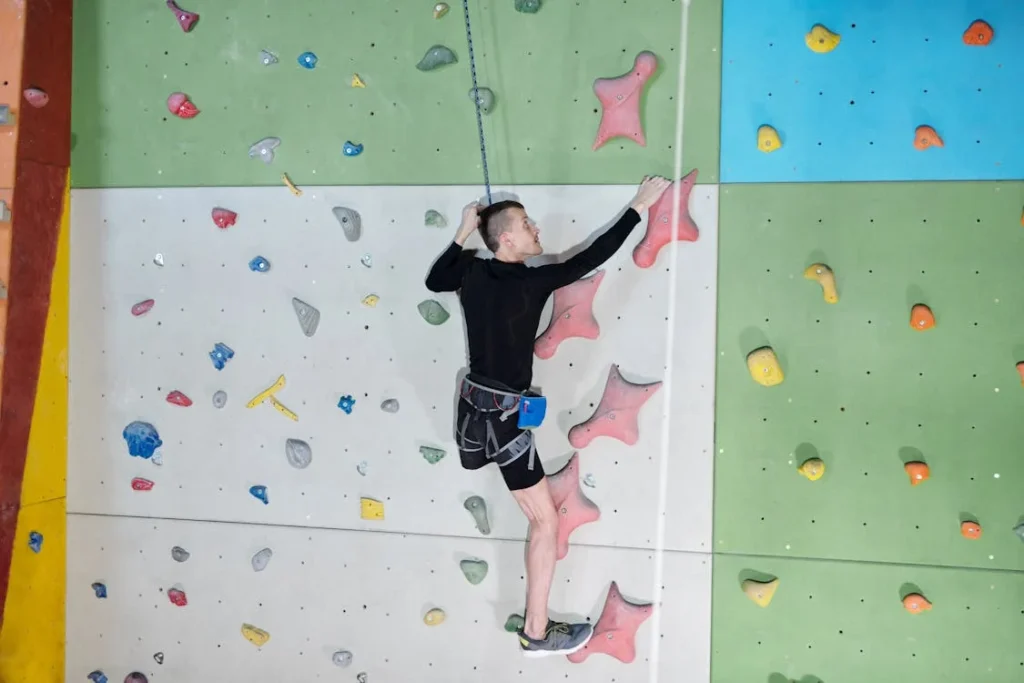
Designing Better Recovery Systems: What Makes Gamification Truly Effective
Not All Games Are Equal — It’s About Purposeful Design
While the term “gamification” might suggest fun and play, it’s important to remember that not every game-like experience is useful in physical therapy. Slapping points onto a task or adding colorful graphics isn’t enough.
The most successful rehab games are built with intention. They are designed with clinical precision, engineered to activate specific muscles, improve specific functions, and engage specific parts of the brain — all while keeping the experience meaningful and motivating.
This is where the expertise of clinicians, game developers, and prosthetists must come together. It’s not about turning therapy into entertainment. It’s about creating a targeted experience that speaks to the real, physical needs of the user — and matches the emotional journey they’re on.
A well-designed gamified system should mimic real-world movements. If a patient is trying to improve elbow control, the game should require that exact motion — not just random gestures. If balance is the goal, the challenges should involve postural shifts and weight transfers that reflect walking, climbing, or standing still. Every virtual activity should serve a real therapeutic purpose.
Customizing Difficulty to Avoid Frustration or Boredom
One of the greatest advantages of gamified rehab is its ability to adapt. Unlike fixed routines, a good game adjusts in real time to the patient’s ability. If a user struggles with a certain movement, the system can lower the difficulty or offer hints. If they master a challenge quickly, the system can raise the bar. This ability to dynamically scale difficulty is critical for sustained engagement.
Why? Because frustration kills motivation. If a game is too hard, the patient feels defeated. If it’s too easy, they feel disinterested. But when the challenge hits that sweet spot — just difficult enough to feel meaningful, but achievable enough to feel rewarding — the user enters a psychological state called flow.
Flow is the golden zone of focus and satisfaction. It’s when time disappears, effort feels natural, and actions come easily. People in flow learn faster, perform better, and feel happier. A properly designed rehab game strives to create flow — not by chance, but by carefully calibrating pace, feedback, and reward systems.
Visual and Audio Feedback That Matters
While aesthetics can enhance motivation, they must also be functional. In rehab, visual and audio cues play an essential role in guiding behavior. A bright flash when a patient completes a movement correctly tells them they’re on the right path. A soft alert if the motion is off helps them course-correct without stopping the entire session. These micro-feedback loops help the brain associate intention with result.
Sounds, too, are powerful. Uplifting music, soft tones of success, or celebratory chimes all feed the brain’s need for recognition. They reinforce effort with a sense of achievement — even when the movement was small. But again, they must be used thoughtfully. Too much noise can be distracting. Too little feedback, and the user might feel lost.
At Robobionics, we pay close attention to these design layers. Every beep, flash, or vibration serves a purpose. It’s not about decoration — it’s about communication between the game and the user’s brain. When that communication is clear, recovery becomes smoother and more responsive.
Tracking Progress in a Way That Builds Confidence
A common pain point in rehab is the feeling that progress is invisible. You show up, do the work, and go home — but how do you know it’s working? Patients need more than just therapist feedback. They need visual proof.
Gamified systems solve this with dashboards, graphs, and in-game achievements that show trends over time. You might see how your reaction time improved week to week. Or how your movement accuracy went from 60% to 90% in two months. These aren’t just numbers — they’re evidence of hard work paying off.
Even better, this data can be shared with the therapist, family members, or even other patients. It opens up new layers of accountability and celebration. A patient who once felt like they were falling behind now sees themselves climbing — bit by bit — and that fuels further effort.
Making the Experience Personal
Every patient is different — in their body, in their mind, and in their journey. One-size-fits-all therapy doesn’t work. That’s why the best gamified platforms allow for deep personalization. Patients can often choose their avatar, the game world, their goals, or even the type of reward that motivates them most.
For some, it’s climbing levels. For others, it’s building a virtual garden. For someone else, it might be collecting tokens or racing a timer. This range of options lets patients see their own story reflected in the experience. And when they feel seen, they engage more deeply.
We’ve even seen patients create friendly competitions with each other, comparing scores, sharing progress, or teaming up in cooperative challenges. These micro-communities create a new source of strength — one that goes beyond the screen and into real human connection.
Accessibility and Inclusion: A Crucial Design Pillar
Finally, an effective gamified rehab tool must be accessible to all. That means it must work for different age groups, abilities, and educational levels. It should support patients with visual impairments, limited mobility, or cognitive difficulties. It should offer language options, adjustable sensitivity, and clear instructions.
Gamification should include, not exclude. The design must make it easy to start, easy to follow, and satisfying to continue — whether the patient is a tech-savvy teenager or a senior citizen new to smartphones.
At Robobionics, we’re committed to designing systems that respect the user’s whole experience — physical, emotional, and cultural. Because recovery should never feel confusing, intimidating, or isolating. It should feel empowering. And great design is what makes that possible.
Conclusion
Gamification isn’t a trend — it’s a transformation in how we think about recovery. By combining psychology, neuroscience, and thoughtful design, it turns physical therapy into a deeply human experience that motivates, empowers, and heals. It gives patients more than just exercises — it gives them a reason to keep going, a way to measure progress, and a sense of purpose.
At Robobionics, we’ve seen firsthand how gamified rehab rewires more than muscles. It rebuilds confidence, lifts spirits, and creates momentum where there was once resistance. And as prosthetic users across India engage with these smarter, more responsive systems, they’re not just recovering — they’re thriving.
Because when therapy is guided by joy, feedback, and emotional connection, recovery doesn’t feel like a burden. It feels like a win.
The future of healing is here — and it plays to our strengths.



